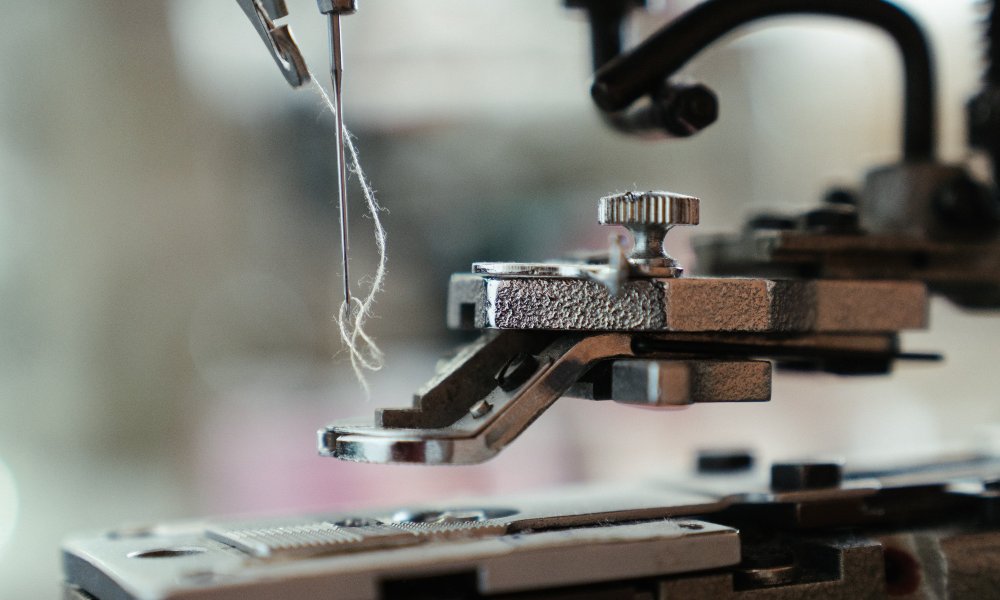Have you noticed skipped stitches or damage to your fabric when sewing lately? It may be time to change your sewing machine needle. While it’s a simple task, changing your needle regularly is an essential piece of sewing machine maintenance. Learn why, how, and when to change your needle.
Why Change Your Sewing Machine Needle?
As you use your sewing machine over time, the needle will naturally become dull from repeatedly piercing fabric. A dull needle can cause all kinds of trouble in your stitching. Skipped stitches giving uneven stitching is a standard indicator that your needle has become dull. A dull needle may also damage delicate fabrics by pulling or puckering the material. Changing your sewing machine needle before it reaches this point will help prevent frustration and damage while sewing.
Beyond replacing a dull needle, matching your needle type properly to the fabric you are sewing is essential. Woven fabrics like quilting cotton usually require a universal needle. But needles also come in types specifically designed for knits, stretch fabrics, silky fabrics, denim and more. Using the recommended needle for your fabric type results in smooth, even stitches without skips or damage. So, changing your needle means you can keep the right needle for the fabric.
How to Change the Sewing Machine Needle
Changing a sewing machine needle is a quick and straightforward maintenance task once you know how:
Select the Correct Needle
The first step in changing your sewing machine needle is to consult the instruction manual. This will guide the correct needle size and type for your fabric and machine model. Well-known needle brands such as Schmetz and Organ make needles in various sizes and specialty options.
With the manual’s recommendations, you can now remove the dull needle in your machine. A screwdriver or specialized needle insertion tool helps loosen the screw that secures the needle in the clamp. Take care when loosening the screw and pulling down on the needle to remove it from the clamp. Safely discard the used needle once removed.
Now, you’re ready to insert the new needle purchased for your project. Position the needle with the flat side facing back, away from you. Push it up into the needle clamp as far as possible before tightening the screw securely again. Take care not to over-tighten. The needle should now be locked firmly into position, ready for sewing.
Ensure that the new needle is fully inserted into the needle clamp. Ensure that the needle’s flat side is directed towards the sewing machine’s back, facing away from you. Push the needle up into the clamp as much as possible, and then securely tighten the needle clamp screw to keep it in place. Be careful not to over-tighten.
Common Sewing Machine Needle Types

Now that you know how to change the needle, here is an overview of some of the most common needle types and their best uses:
Universal Needles
These are suitable for most woven fabrics like quilting cotton and are the most commonly used. Universal needles are available in sizes ranging from 60/8 to 120/19 and are equipped with a point that is slightly rounded.
Ballpoint Needles
Ballpoint needles have a more rounded point and are designed for sewing knits and stretchy fabrics without damaging the material. The rounded point slips between the knit fibers rather than piercing them.
Quilting Needles
Quilting needles are heavier than other needles. They are made for stitching through multiple layers and thicker threads used in quilting. The extra sharp point easily pierces through the layers.
Stretch Needles
As the name suggests, these needles are ideal for stretchy and knit fabrics. The wider scarf prevents skipped stitches on flexible knits. Stretch needles also have a ballpoint tip, just like ballpoint needles.
Denim Needles
Denim needles are extra strong to sew through multiple layers of heavy denim without bending or breaking. They have an acute point and reinforced shaft.
Leather Needles
Leather needles have a wedge-shaped point designed to pierce leather without leaving large holes — the sharp cutting edge slices neatly through the material.
Frequently Asked Questions
Why does my needle keep breaking?
You may be using the wrong type or size needle for your fabric. A needle that is undersized may become deformed or fractured. Check your manual for the proper needle recommendations.
How do I know when to change the needle?
Change your sewing machine needle every 4-6 hours of sewing time. Also, change the needle if it is dull, bent, or causing skipped stitches. Damaged fabric can also indicate a dull needle.
Can I use a universal needle for all fabrics?
Universal needles work for most woven fabrics, but specialty needles are recommended for knits, stretch, denim, leather, and heavy fabrics.
What size needle should I use?
Consult your machine manual for the recommended needle size for your fabric type. Standard sizes range from 60/8 for light fabrics up to 120/19 for heavy fabrics.
How do I insert the needle correctly?
Make sure the flat side of the needle faces backward, away from you. Push it up into the clamp as far as it will go before tightening the screw.
Conclusion
Replacing and changing your sewing machine needle regularly makes a noticeable difference in your stitching and results. Skipped stitches, uneven seams, puckered fabric, and snagged materials are all signs that it’s time to change the needle. Follow your machine manual’s recommendations for needle size and type for your fabric. Changing the needle frequently helps your machine sew smoothly and prevents frustration! What other sewing machine maintenance do you do regularly to keep it running in top shape? Changing needles should be at the top of your list.
***
Main image: pexels




